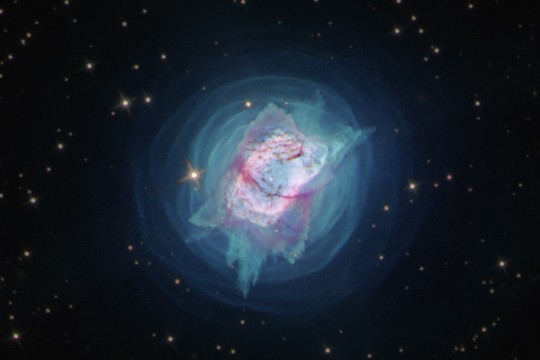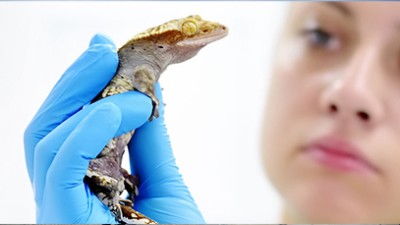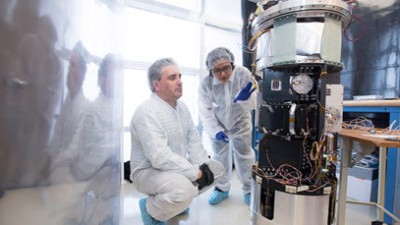News
Astrophysical Sciences and Technology MS
-
August 5, 2020

RIT student Justin Gallagher helps lead NASA-funded project to build single photon detectors
An RIT student is on a mission to help build detectors that could identify individual photons from distant, inhabitable planets. Justin Gallagher, a fifth-year student from Rochester, N.Y., pursuing his BS in physics and MS in astrophysical sciences and technology, is serving as project manager for a nearly $1 million grant funded by NASA to create a single photon sensing and number resolving detector for NASA missions.
-
June 18, 2020

X-rays From a Newborn Star Hint at Our Sun's Earliest Days
NASA mentions Joel Kastner, professor in the Chester F. Carlson Center for Imaging Science and School of Physics and Astronomy, and alumnus David Principe '10 Ph.D. (astrophysical science and technology) for being part of a team that observed an X-ray flare from a very young star using NASA's Chandra X-ray Observatory.
-
June 18, 2020

Hubble Provides Holistic View of Stars Gone Haywire
NASA features Joel Kastner, a professor in RIT’s Chester F. Carlson Center for Imaging Science and School of Physics and Astronomy, and astrophysical science and technology Ph.D. students Jesse Bublitz and Paula Moraga on their latest Hubble telescope observations.
-
March 4, 2020

Weekly Space Hangout: Did RIT Scientists Find A Baby Giant Planet?
Universe Today features Joel Kastner, professor in the Chester F. Carlson Center for Imaging Science, and astrophysical sciences and technology Ph.D. students Annie Dickson-Vandervelde and Emily Wilson.
-
February 10, 2020

RIT scientists discover the nearest-known ‘baby giant planet’
Scientists from RIT have discovered a newborn massive planet closer to Earth than any other of similarly young age found to date. The baby giant planet lies only about 330 light years from our solar system. The discovery, published in the Research Notes of the American Astronomical Society, provides researchers an exciting new way to study how gas giants form.
-
December 12, 2019

RIT and IAR observe pulsars for the first time from South America
A team from RIT and the Instituto Argentino de Radioastronomía (IAR) upgraded two radio telescopes in Argentina that lay dormant for 15 years in order to study pulsars, rapidly rotating neutron stars with intense magnetic fields that emit notably in radio wavelengths. The project is outlined in a new paper published in Astronomy and Astrophysics.
-
November 20, 2019

Baby Black Holes May be Orbiting Supermassive Black Holes
Futurism cites research by Richard O’Shaughnessy, assistant professor in the School of Mathematical Sciences.
-
November 18, 2019

Researchers prepare rocket for launch
A team of RIT researchers is helping launch an experiment above the atmosphere to better understand extragalactic background light, which traces the history of galaxies back to the formation of the first stars in the universe.
-
November 8, 2019

New study suggests ‘Pac-Man-like’ mergers could explain massive, spinning black holes
Scientists have reported detecting gravitational waves from 10 black hole mergers to date, but they are still trying to explain the origins of those mergers. The largest merger detected so far seems to have defied previous models because it has a higher spin and mass than the range thought possible. A group of researchers, including RIT Assistant Professor Richard O’Shaughnessy, has created simulations that could explain how the merger happened.
-
November 5, 2019

Watch the planet Mercury pass in front of the sun with the RIT Observatory
The planet Mercury will pass directly across the sun next week for the last time until 2032, and RIT faculty and students will help the community view the rare event. Members of the RIT Observatory will set up telescopes for public use from 7:30 a.m. to 1 p.m. on Monday, Nov. 11, in the Infinity Quad on the RIT campus.
-
October 25, 2019

Shedding light on black holes
The Christian Science Monitor talks to Manuela Campanelli, professor and director of the Center for Computational Relativity and Gravitation.
-
October 4, 2019

New tech at RIT may help find other planets
WROC-TV talks to student Justin Gallagher and Professor Don Figer, director of the Center for Detectors, about a sensor technology that may contribute to finding other planets.




